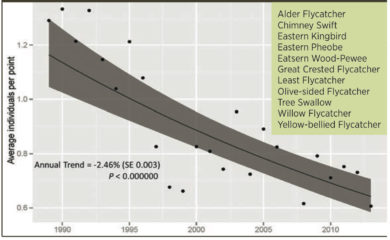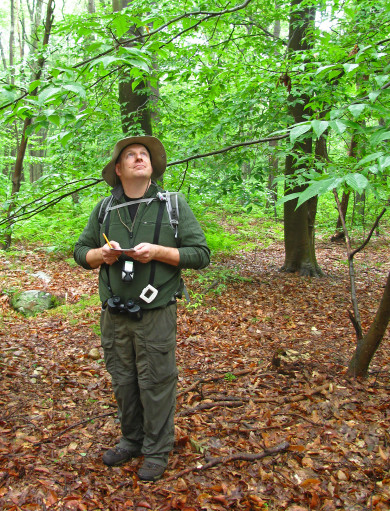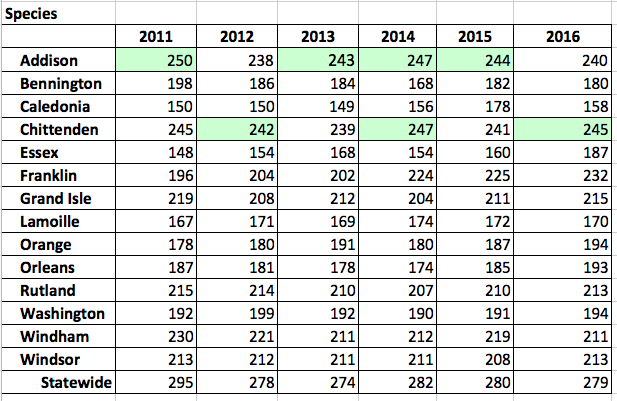How often have you looked at a ubiquitous Red-tailed Hawk on a roadside pole, a nearby tree, or soaring overhead, and wondered aloud about how it just looks different … or wondered if it even was a Red-tail? We all know that Vermont’s most familiar hawk comes in different sizes, shades, and plumage patterns. But is it just different individuals, ages, and sexes, or could it be birds from different, recognizable subspecies?
Recently it has become more and more clear, especially during the non-breeding months, that in New England and adjacent New York more than one subspecies shares our open lands and fringing forests.
Subspecies are named populations of a species which have distinctive ranges, behaviors, and identifying visible and/or vocal traits. They may or may not be easy for most of us to tell apart. Red-tailed Hawks currently have nine recognized subspecies in eBird, all limited globally to North and Central America. Only three are known from New England and adjacent New York:
- “Eastern Red-tailed Hawk” (Buteo jamaicensis borealis) – ubiquitous.
- “Northern Red-tailed Hawk” (Buteo jamaicensis abieticola) – present in non-breeding months but little documentation.
- “Western/Southern Alaskan Red-tailed Hawk” (Buteo jamaicensis calurus/alascensis) – apparently rare in the Northeast.
If you are a birder in Vermont, be on the watch for, and help us learn more about these subspecies (especially abieticola) in the state, as we know very little at this point in time! On a cold and blustery day, maybe you want to go back through old Red-tailed pictures and tackle subspecies ID or just marvel at the variation (it is now super easy to upload photos to a Vermont eBird checklist!).
Cautions and pitfalls in identifying subspecies
Subspecies are not species. It commonly takes a different mindset to see and document subspecies than species. Often variability abounds, clinal features will frustrate, and un-identifiable birds can be the norm. Reliable diagnostic characteristics may be little known, work only with statistical analyses, or be hard to see. Caution and careful observations are the watch-words. Do not expect to be able to identify all, many, or even just occasional birds to subspecies.
Individuals of different subspecies can freely interbreed. As with the species as a whole, there is variation in the appearance of individuals within a subspecies population. Subspecies distinctions may not exist, or be apparent, among juvenile or immature individuals. In general, the difference in look between subspecies of a species will be less obvious than the difference between the species as a whole and other, similar species. Depending upon the subspecies, a few diagnostic features might define it, or it might require numerous supporting features to clearly delineate an individual of a subspecies.

An adult ‘Eastern’ Red-tailed Hawk (Buteo jamaicensis borealis) from Springfield, VT in February 2017. Some B. j. borealis have much less obvious bellybands, but this individual can be separated from B. j. abieticola by the combination of pale supercilium, unstreaked white breast, and lack of rufous tones.
Identification
Identification of Red-tailed subspecies is hard. Many will not be identifiable, even by experts. Most of the variation among individuals is not related to subspecies status. Birds with subspecies characteristics at the extremes of the spectrum, however, may be relatively straightforward to identify (with the help of some background reading). For those who really want to tackle this, there are a handful of additional resources below.
As is the case with many challenging identifications, it’s often a good idea to determine the age of the bird when making an ID. This is definitely true for subspecies identification of Red-tails. Also, as is the case with many buteos, there are light and dark phase morphs within a species … sometimes helping to define a subspecies, but at other times just part of the variation within a subspecies.
The following discussion compares the principal subspecific distinctions between the common subspecies B. j. borealis and the likely occurring B. j. abieticola.
Immature birds: Immature Red-tails lack the red in the tail, but still have other identifying features including a bellyband. There is considerable variation in this plumage and identification of subspecies is difficult at best, or impossible, given the apparent overlap between juvenile and immature B. j. borealis and B. j. abieticola. It is always worthwhile to include photographs on eBird checklists, as maybe someday there will be more information that allows identification to the subspecies level. Also, it is a good idea to double check immature birds closely as young Red-shouldered Hawks can be surprisingly similar and have been reported occasionally in Vermont during the winter.
Light-morph adults: If the bird has a red tail and at least some white underneath, it’s a light-morph adult. These are the individuals most likely to be identifiable to a subspecies, including B. j. abieticola.
In general, B. j. abieticola are darker with heavier marks and warmer colors. The bellyband of B. j. abieticola has been described as dark blotches with a background of herringbone shaped marks. The bellyband of B. j. borealis ranges from a few, faint marks to a complete band (similar the photo below) that can approach B. j. abieticola.
Many B. j. abieticola also have completely dark heads with a golden sheen whereas B. j. borealis often show a paler head with a pronounced supercilium. It can also be helpful to note the pattern of the throat and breast, as B. j. abieticola tends to have a dark or heavily marked throat and at least some streaking on the upper breast.
From behind, B. j. borealis tend to have more white splotches on the back and shoulders, whereas B. j. abieticola can be a relatively solid dark brown. Confident identifications probably are only possible when most or all of these characteristics agree. Also note that ‘Western’ Red-tailed Hawks (B. j. calurus/alascensis) have a light-morph form that can be similar to B. j. abieticola, but is probably exceedingly rare in Vermont.
Dark morphs: These all black/brown birds are very rare in the East, but have been reported from Vermont once or twice. The first step is to well see and document the tail color and patterning in order to confirm the bird is a Red-tailed Hawk and not a dark-morph Rough-legged Hawk. Be aware that dark-morph Rough-legged Hawks are regularly found in the winter in parts of the state.
Dark-morph Red-tailed Hawks apparently are not known to occur in either B. j. borealis or B. j. abieticola. Thus dark morph birds likely represent a western subspecies (probably B. j. calurus/alascensis) that has not yet been confirmed from Vermont. Any sighting should be fully documented, ideally photographed, and a report submitted to the Vermont Bird Records Committee.
Albino or Leucistic birds: These all-white or abnormally patterned Red-tailed Hawks are surprisingly common and have been photographed in several parts of the state in recent years. Subspecies identification is probably impossible for most of them, thus they should be submitted under the generic Red-tailed Hawk option.
Reporting to the Vermont Bird Records Committee
At this writing, any birds considered to be a subspecies, other than B. j. borealis, should be submitted to the Vermont Bird Records Committee via a Rare Species Documentation form (RSD).
Guidelines for submitting to Vermont eBird
Red-tailed Hawks not considered for subspecies identity should only be submitted as Red-tailed Hawk, and not as Red-tailed Hawk (borealis).
 When reporting Red-tailed Hawks to Vermont eBird, you may have already noticed that if you click the ‘show rarities’ box, you will see multiple options as illustrated here in the eBird mobile app. It will look different if you are submitting via a computer. The listing of subspecies definitely does not mean that you must choose one of the subspecies options.
When reporting Red-tailed Hawks to Vermont eBird, you may have already noticed that if you click the ‘show rarities’ box, you will see multiple options as illustrated here in the eBird mobile app. It will look different if you are submitting via a computer. The listing of subspecies definitely does not mean that you must choose one of the subspecies options.
If you think you know which subspecies you saw, then choose the appropriate one and fill in all the details you can just as you would for a rare species. If possible, attach photos to any and all Red-tailed Hawks you find.
It is possible (even likely) that a single checklist will have multiple subspecies and/or Red-tails that can’t be assigned to subspecies—check out this eBird checklist with all three options.
Vermont eBird has decided to keep all subspecies listed as rare until we have a better understanding of seasonality and abundance of both expected subspecies. Although B. j. borealis is quite common, the submission of an observation of the subspecies implies there is evidence that eliminates all other possible subspecies.
As always, enjoy the diversity of bird life in Vermont — including these subtleties of our familiar Red-tailed Hawk!
Spencer Hardy and Ian Worley, Vermont eBird Regional Editors
Additional Resources
Source: eBird VT Birdwatching

















